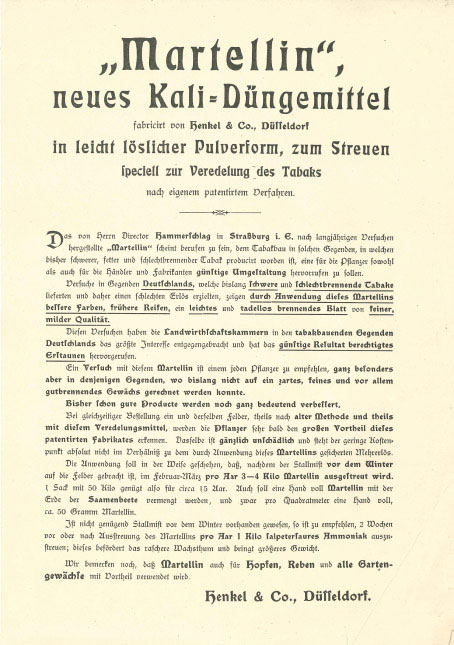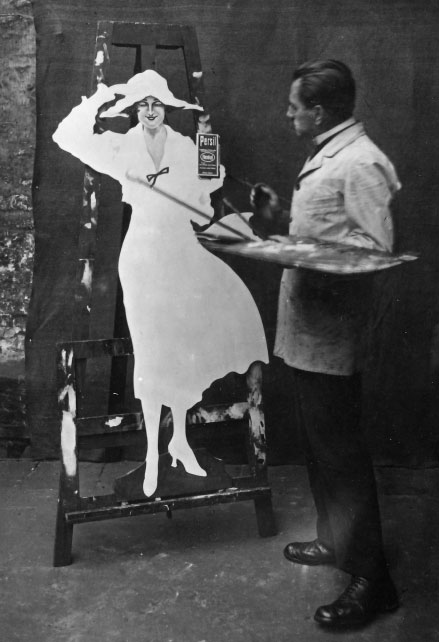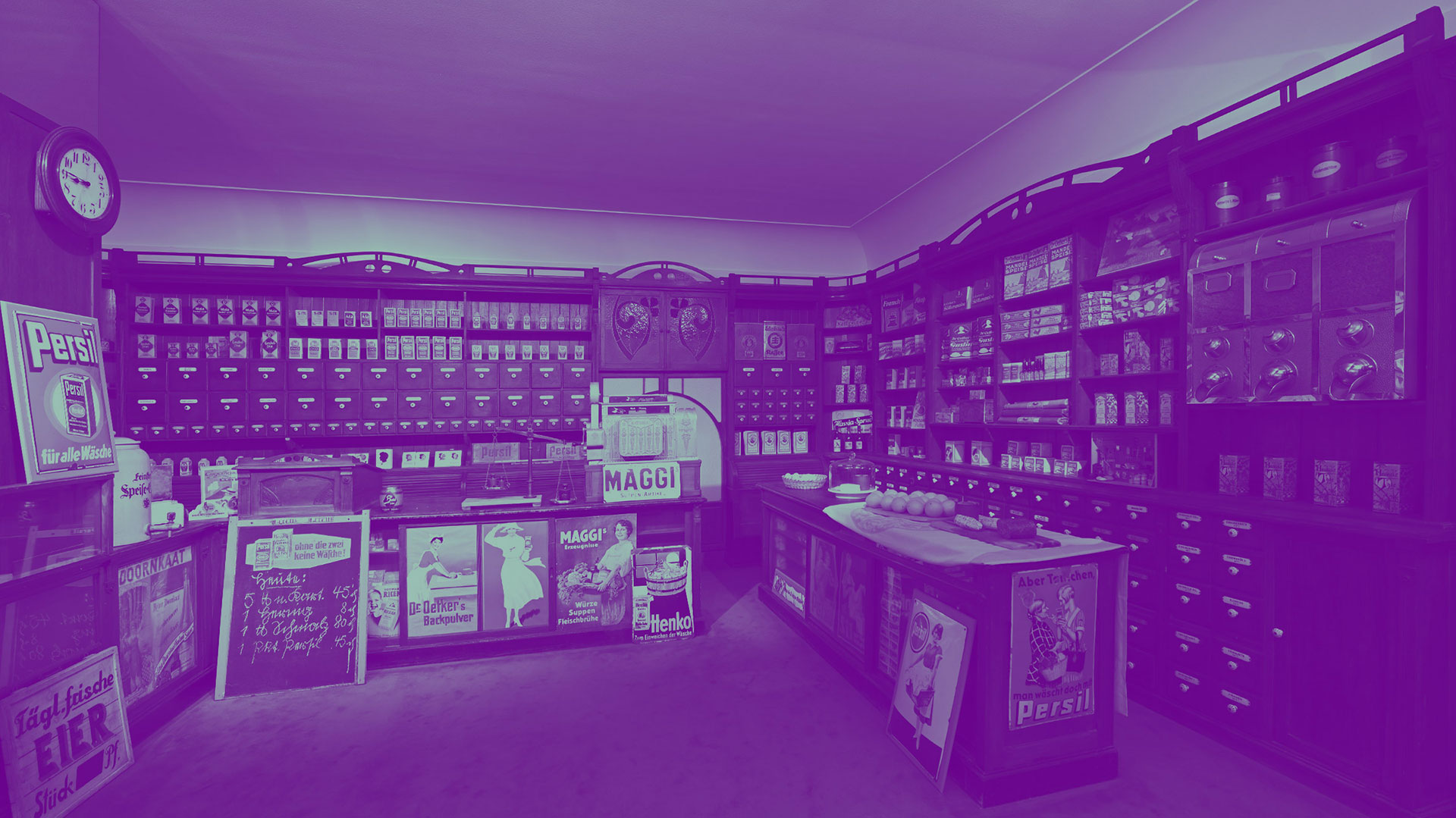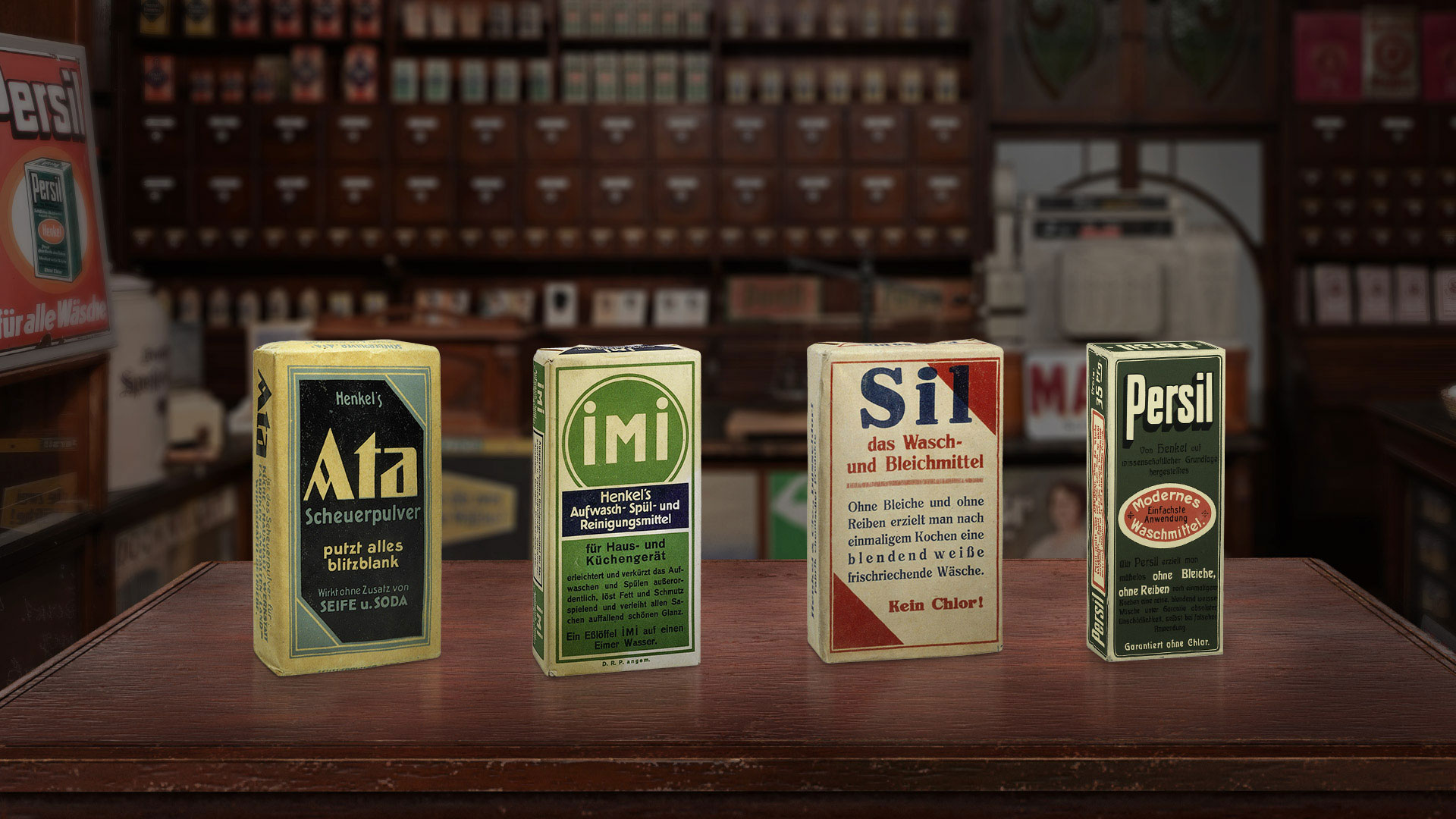The Brand Pioneer
From the idea to the shelf
From flop to top
The first step is the hardest: Henkel’s first product, Universal-Waschmittel (universal detergent) did not win consumers over. Its washing performance was just not good enough. In early 1878, however, Henkel’s Bleich-Soda (bleaching soda) was a real game-changer: The second-generation laundry detergent developed by Fritz Henkel himself became the company’s first resounding brand success.
Henkel's Bleich-Soda, like Universal-Waschmittel in 1876, was sold in prepackaged packets – a revolutionary idea at the time.


Marketing by packaging
For enhanced brand recognition, the packages of Henkel’s Bleich-Soda (bleaching soda) featured the brand name and the company logo – a lion against the backdrop of the sun’s rays. Fritz Henkel was one of the first to offer a laundry detergent as a branded article and to use the packaging to advertise his product.
The brand name Henkel’s Bleich-Soda and the lion became a registered trademark in 1878. Even though the logo was replaced by today’s Henkel oval in 1961, it is still one of the oldest German trademarks.
All under one roof
Grocery stores offered all kinds of everyday products, among them food articles such as milk and butter, but also detergents like Henkel’s Bleich-Soda (bleaching soda) and later Persil.
Many of these products were bulk goods to be weighed and filled for the customer in the store. This made Henkel products special: They were offered pre-packed in standardized boxes or bags and sold at a binding price that was fixed by the manufacturer. This and the associated promise of quality were new at the time. Henkel was thus a pioneer in the field of branded consumer goods.
Expanding the product range
Traveling reps who offered grocery stores – their most important clients – a wider product range had a head start over the competition. Fritz Henkel therefore complemented his early offering of Henkel’s Bleich-Soda with other merchandise. Most of these products generated very little sales though, so they were phased out between 1887 and 1889.
Henkel’s Thee (tea), however, was newly included in the product offering in 1887. At the time tea was sold in Germany loose only, forfeiting its flavor fast when stored in poor conditions. Henkel’s innovation featured decorative, aroma protecting tin boxes. The tea business ended in 1913, when Persil became Henkel’s sales driver.

“It soon turned out that it made good sense to offer the grocery stores other goods beyond bleaching soda.”
The quote refers to the pre-Persil years (1907), when Henkel’s Bleich-Soda was still the company’s main product. In order to operate profitably, the company also sold other merchandise.
Brand history milestones
Very early in its history, Henkel started to extend its product offering. Check out the timeline below to find out more about the milestones of its brand history up till 1930.
Detergents, cleaners and adhesives: the foundations of success

Persil
In 1907, the launch of Persil revolutionized women’s labor in the laundry room. The first self-acting detergent made Henkel the undisputed leader in the German detergent market.

Adhesives
Adhesives production at Henkel started in 1922. Originally for in-house use only, the adhesives were soon sold to neighboring companies as from 1923. This marked the start of a new business segment for Henkel and was the beginning of a global success story.
Impressively
creative
After the company’s first big success with Henkel’s Bleich-Soda, the product range was steadily extended. Aside from selling Henkel’s Thee, the company also launched its own product creations such as Putzpomade (kitchen polish) and Ultramarin (a laundry bluing agent).

Today, some of the products might seem strange for the Henkel range. However, they were a result of Henkel’s early ambition to use and reuse as many raw material components as possible. One example was Henkel’s animal feed. It was made from palm kernel and soybean meal – a by-product of soap production.
A few of the best examples of these special products can be found here.

Fertilizer
In 1898, Henkel launched Martellin, a potash fertilizer based on water glass. It was particularly suited for tobacco and hop plants, and for vines. The fertilizer powder was sold mainly in the Alsace region of France and Southern Germany.
In 1902, the fertilizer range was extended with the flower fertilizer Floral.

Huhn im Winter
Huhn im Winter (“hen in winter”) was an egg preservative based on water glass. Alkali silicate was mixed with water to achieve a semi-solid substance. When fresh eggs were placed into the solution, their shell pores were sealed. This helped to conserve eggs over winter by protecting them from water, air and bacteria intrusion.

Antifreeze protection
In the late 1920s, more and more cars traveled the roads and the demand for glycerol as a component of cooling agent increased accordingly. When Dr. Hugo Henkel returned from a trip to the USA in 1928, he saw a new market opportunity. In 1929, Henkel launched its Dixol antifreeze agent for car radiators.

An advertising figure conquers the brand world
The Lady in White was created in 1922, and she still remains the company’s most famous advertising figure. Up until the 1960s, the Lady in White promoted Persil in newspapers, on posters, and on enamel signs, thus contributing significantly to the success of the brand.
“We realized that selling an article and making it available in the shops was not enough. We needed to sell it with verve and passion.”
The founder at the annual conference of his traveling reps, 1910

Different.
Surprising.
Visionary.
Right from the start, Fritz Henkel pursued a powerful advertising strategy to draw consumer attention to his products. However, the cities were already full of advertising at the beginning of the 20th century, so a way had to be found to stand out from the competition. In addition to classic forms of advertising, such as posters or newspaper ads, Fritz Henkel diversified the ad portfolio. Whether with illuminated signs, films, or Persil clocks: Henkel always made use of novel advertising methods with a sure sense of their impact. The campaigns were further supported by the so-called traveling “instructresses” (demonstrators) and the traveling salesmen who promoted the company’s products in the field.
Fritz Henkel and his
employees
The founder was very much aware of the importance of his employees. That is why the next section is dedicated to that topic. Check it out!
























